When it comes to transporting oversized or heavy machinery, construction equipment, or industrial components, the right trailer can make all the difference. Among the various options available, lowboy trailers stand out for their unique design and unparalleled functionality. At CarMax Vehicle, we specialize in manufacturing high-quality lowboy trailers that cater to the diverse needs of our clients. This comprehensive guide delves deep into how lowboy trailers work, their key components, advantages, applications, and maintenance, ensuring you have all the information you need to make an informed decision.
Table of Contents
- Introduction to Lowboy Trailers
- Design and Structure of Lowboy Trailers
- Key Components and Their Functions
- Operational Mechanics: How Lowboy Trailers Work
- Advantages of Using Lowboy Trailers
- Common Applications of Lowboy Trailers
- Comparing Lowboy Trailers with Other Trailer Types
- Safety Features and Best Practices
- Maintenance and Care for Longevity
- Why Choose CarMax Vehicle for Lowboy Trailers
- Frequently Asked Questions
Introduction to Lowboy Trailers
Lowboy trailers are specialized transport vehicles designed to carry heavy and oversized loads that exceed standard trailer dimensions. Their low deck height minimizes the center of gravity, making them ideal for transporting construction machinery, mining equipment, and agricultural implements. The versatility and robustness of lowboy trailers make them a preferred choice among industries that demand reliability and efficiency in transporting massive loads.
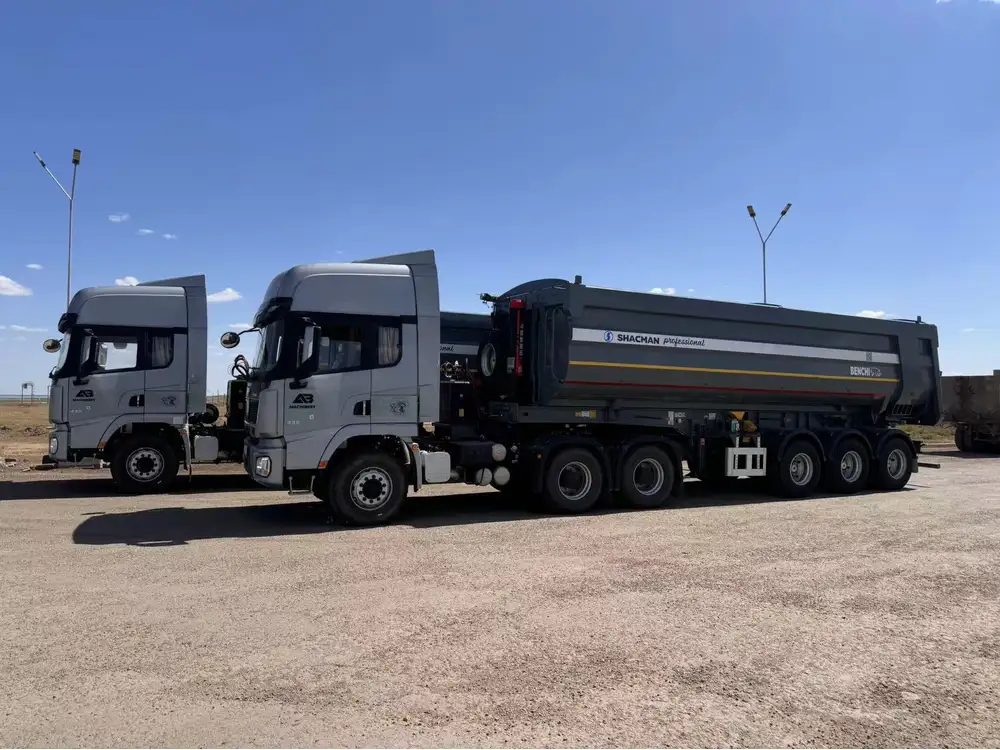
Design and Structure of Lowboy Trailers
The design of a lowboy trailer is pivotal to its functionality. Unlike conventional flatbed trailers, lowboys feature a lower deck height achieved through a dual-axle or tridem axle configuration. This design reduces the overall height, allowing for the transportation of taller machinery without exceeding legal height limits.
Key Design Features:
- Lower Deck Height: Facilitates the transport of tall and heavy equipment by keeping the load close to the ground.
- Extended Length: Provides ample space for long loads, minimizing the need for multiple trailers.
- Articulated Hitching System: Ensures stability and maneuverability during transit.
- Robust Frame Construction: Built to withstand the stresses of heavy loads and rough terrains.
| Design Feature | Lowboy Trailer | Standard Trailer |
|---|---|---|
| Deck Height | Significantly lower | Higher |
| Load Capacity | Higher, typically up to 100+ tons | Usually up to 80 tons |
| Maneuverability | Enhanced due to lower center of gravity | Moderate |
| Versatility | Suitable for various oversized loads | Limited to standard-sized loads |
Key Components and Their Functions
Understanding the key components of a lowboy trailer is essential to grasp how these trailers operate efficiently.
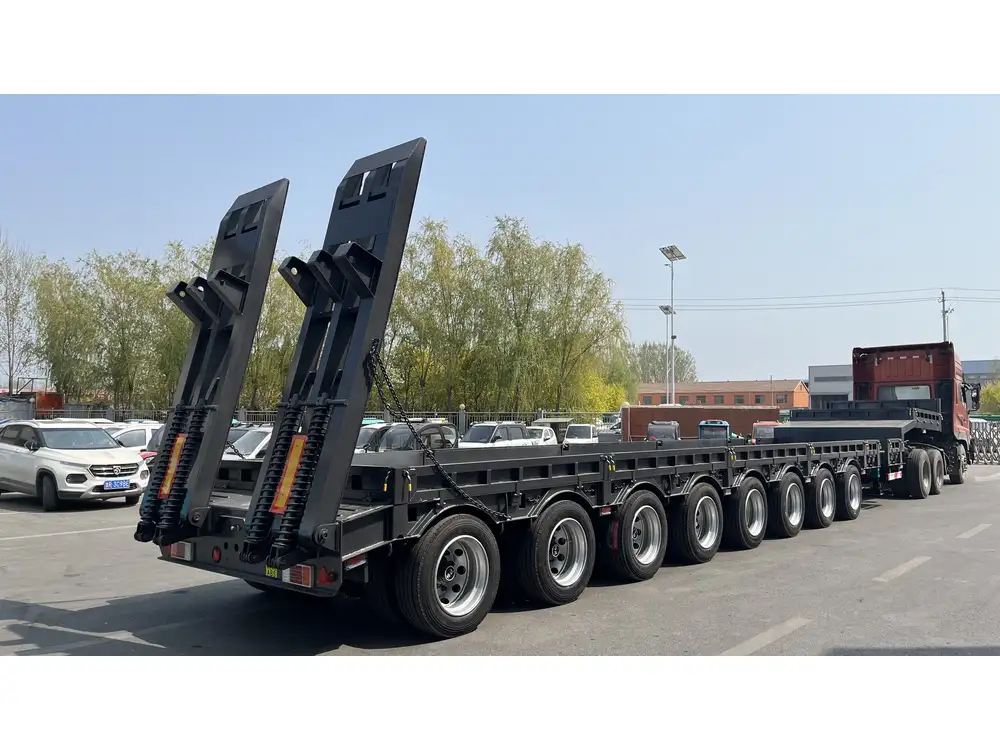
1. Frame
The backbone of the trailer, typically constructed from high-strength steel. The frame must support heavy loads and endure the rigors of transportation.
2. Axles and Suspension
Lowboys are equipped with multiple axles and advanced suspension systems that distribute weight evenly, ensuring stability and reducing wear on both the trailer and the road.
3. Decking
The platform where the load rests, often made of reinforced steel to handle heavy weights. Some lowboys feature removable or adjustable decks to accommodate different load types.

4. Hitching Mechanism
Includes the fifth wheel coupling that connects the trailer to the towing vehicle. A strong and reliable hitch is crucial for safe towing.
5. Landing Gear
Supports the trailer when it’s not connected to a towing vehicle. Adjustable landing gears are essential for leveling the trailer and facilitating loading and unloading.
6. Winches and Tie-Down Points
Essential for securing loads, preventing shifting during transit. Winches aid in the precise placement of heavy items onto the deck.

Operational Mechanics: How Lowboy Trailers Work
Lowboy trailers operate on a straightforward yet robust mechanical system designed for efficiency and safety. Here’s a step-by-step breakdown of their operational mechanics:
1. Loading the Equipment
Using cranes or forklifts, heavy machinery is lifted onto the lowboy deck. The low height minimizes the need for excessive lifting, reducing the risk of accidents.
2. Securing the Load
Once the equipment is in place, winches and tie-down straps secure the load. Proper securing is crucial to prevent movement during transit, ensuring the safety of both the cargo and other road users.

3. Connecting to the Towing Vehicle
The fifth wheel coupling on the lowboy aligns with the towing vehicle’s kingpin, creating a secure hitch. The articulated hitch system allows for smooth turns and adjustments while moving.
4. Transmission of Power and Control
The towing vehicle provides the necessary power to move the trailer. The suspension system absorbs road shocks, maintaining load stability and trailer integrity.
5. Navigating Roads
Lowboy trailers, with their enhanced maneuverability, handle winding roads and uneven terrains effectively. The low center of gravity contributes to better stability, especially when carrying off-center or tall loads.
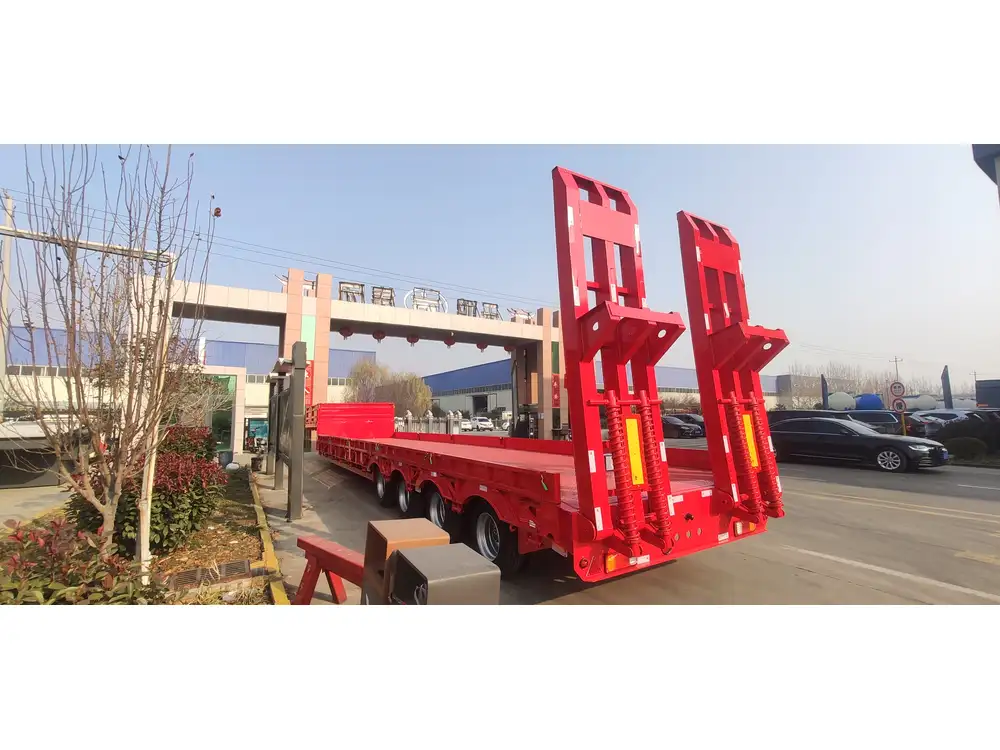
6. Unloading at the Destination
Upon arrival, the landing gears support the trailer. Winches and cranes are used to carefully remove the load from the deck, ensuring the equipment is safely delivered.
Advantages of Using Lowboy Trailers
Lowboy trailers offer numerous benefits that make them indispensable in heavy-duty transportation:
1. High Load Capacity
Capable of transporting loads that exceed standard trailer limits, making them ideal for industries like construction, mining, and agriculture.

2. Versatility
Suitable for a wide range of equipment, from bulldozers and excavators to industrial generators and oversized containers.
3. Enhanced Stability
The low deck height ensures a lower center of gravity, reducing the risk of tipping and enhancing overall stability during transit.
4. Efficient Loading and Unloading
Designed for easy access and minimal lifting height, saving time and reducing labor costs.
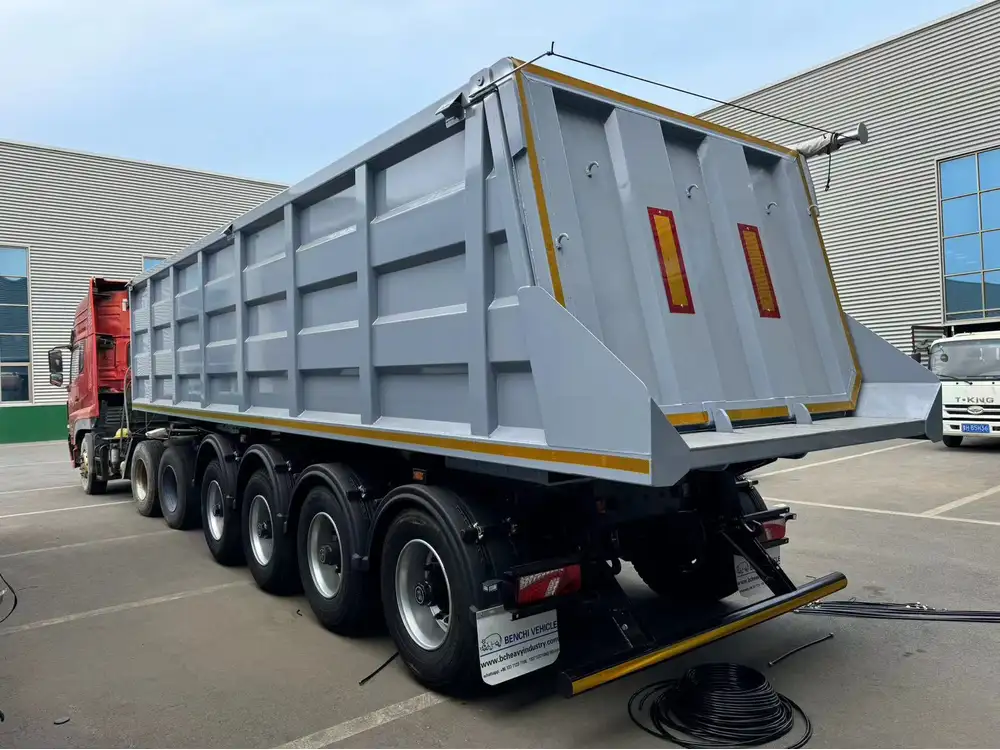
5. Durability and Longevity
Built with high-quality materials and robust construction, ensuring longevity even under heavy usage.
6. Regulatory Compliance
Designed to meet legal height and weight regulations, minimizing the risk of fines and enhancing operational efficiency.
Common Applications of Lowboy Trailers
Lowboy trailers are versatile and find applications across various industries. Some of the most common uses include:

1. Construction Industry
Transporting heavy machinery like cranes, excavators, and bulldozers to and from construction sites.
2. Oil and Gas Sector
Moving drilling equipment, generators, and other oversized components essential for operations.
3. Agricultural Sector
Hauling large farming equipment such as tractors, harvesters, and sprayers.
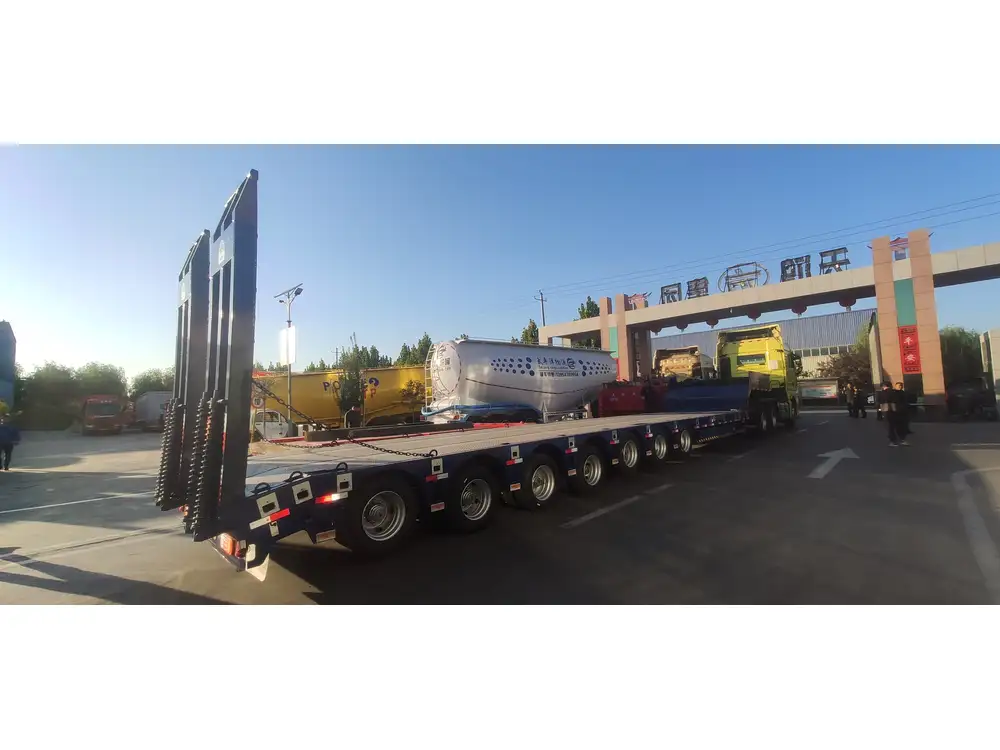
4. Mining Industry
Transporting mining machinery, including drilling rigs, conveyors, and processing equipment.
5. Wind Energy
Moving wind turbine components, including blades, nacelles, and towers, to installation sites.
6. Event Setup
Transporting large structures like stages, lighting rigs, and sound systems for concerts and events.

Comparing Lowboy Trailers with Other Trailer Types
Understanding how lowboy trailers stand out compared to other trailer types helps in making informed decisions based on specific transportation needs.
| Aspect | Lowboy Trailer | Flatbed Trailer | Step Deck Trailer | Extendable Trailer |
|---|---|---|---|---|
| Deck Height | Very low, close to ground | Standard, higher | Lower than flatbed but higher than lowboy | Variable, can be extended |
| Load Capacity | Up to 100+ tons | Typically up to 80 tons | Up to 90 tons | Varies based on extension |
| Suitable Loads | Heavy machinery, oversized equipment | General cargo, machinery | Equipment requiring partial height reduction | Long and variable loads |
| Maneuverability | High, due to low center of gravity | Moderate | Moderate | Lower when extended |
| Loading Mechanism | Requires lifting equipment for low height | Easily accessible from all sides | Requires partial lifting | Requires adjustment for extension |
| Stability | High stability for heavy loads | Moderate | Good for medium-heavy loads | Varies with load and extension |
Lowboy trailers excel in transporting exceptionally heavy and tall loads, offering superior stability and load capacity compared to flatbed and step deck trailers. Their specialized design makes them the go-to choice for industries that deal with oversized and heavy equipment.
Safety Features and Best Practices
Safety is paramount when operating lowboy trailers. Incorporating advanced safety features and adhering to best practices ensures secure transportation of loads and protection of personnel.
Essential Safety Features:
- Anti-Sway Technology: Minimizes trailer sway during transit, enhancing stability.
- Brake Systems: High-performance brakes provide reliable stopping power under heavy loads.
- Lighting and Signage: Clearly visible lights and signage for compliance with road regulations.
- Load Indicators: Ensure proper weight distribution and prevent overloading.

Best Practices:
- Proper Securing of Loads: Always use appropriate tie-downs and ensure loads are balanced to prevent shifting.
- Regular Inspections: Conduct routine checks on the trailer’s components, including brakes, tires, and suspension systems.
- Driver Training: Ensure that operators are trained in handling lowboy trailers and understand the specific challenges associated with heavy loads.
- Compliance with Regulations: Adhere to local and national transportation laws regarding weight limits, height restrictions, and route planning.
- Maintenance Schedule: Follow a strict maintenance routine to identify and address potential issues before they become critical.
Maintenance and Care for Longevity
Maintaining a lowboy trailer is crucial for ensuring its longevity and optimal performance. Regular maintenance not only extends the life of the trailer but also ensures safety and reliability.
Maintenance Tips:
- Routine Cleaning: Remove dirt, debris, and corrosive materials to prevent rust and deterioration.
- Lubrication: Keep moving parts well-lubricated to reduce wear and tear.
- Inspection of Structural Components: Regularly check the frame, axles, and suspension for signs of damage or fatigue.
- Brake Maintenance: Ensure brakes are functioning correctly and replace brake pads as needed.
- Tire Care: Monitor tire pressure and tread depth, replacing tires that show signs of excessive wear.
- Electrical Systems: Check lighting and electrical connections to ensure all systems are operational.

Scheduled Maintenance:
Implement a scheduled maintenance plan that includes daily inspections before use, weekly detailed checks, and monthly comprehensive maintenance tasks. Keeping detailed maintenance records helps in tracking the health of the trailer and planning necessary repairs or part replacements.
Why Choose CarMax Vehicle for Lowboy Trailers
At CarMax Vehicle, we pride ourselves on delivering top-of-the-line lowboy trailers that meet the highest standards of quality and performance. Here’s why partnering with us is the best choice for your transportation needs:
1. Expertise and Experience
With years of experience in trailer manufacturing, our team understands the intricacies of designing and building trailers that cater to diverse industry requirements.

2. Quality Construction
We use premium materials and adhere to stringent manufacturing processes to ensure our lowboy trailers are durable, reliable, and capable of handling the toughest loads.
3. Customization Options
Recognizing that every business has unique needs, we offer customizable solutions, allowing you to tailor the trailer’s specifications to match your specific requirements.
4. Advanced Technology
Incorporating the latest advancements in trailer design and safety features, our lowboy trailers are equipped to provide optimal performance and safety.

5. Comprehensive Support
From initial consultation to after-sales support, our team is dedicated to providing exceptional customer service, ensuring you have the assistance you need at every stage.
6. Competitive Pricing
We offer high-quality trailers at competitive prices, providing excellent value for your investment without compromising on quality.
7. Sustainability Commitment
Our manufacturing processes prioritize sustainability, ensuring that our trailers are not only built to last but are also environmentally responsible.
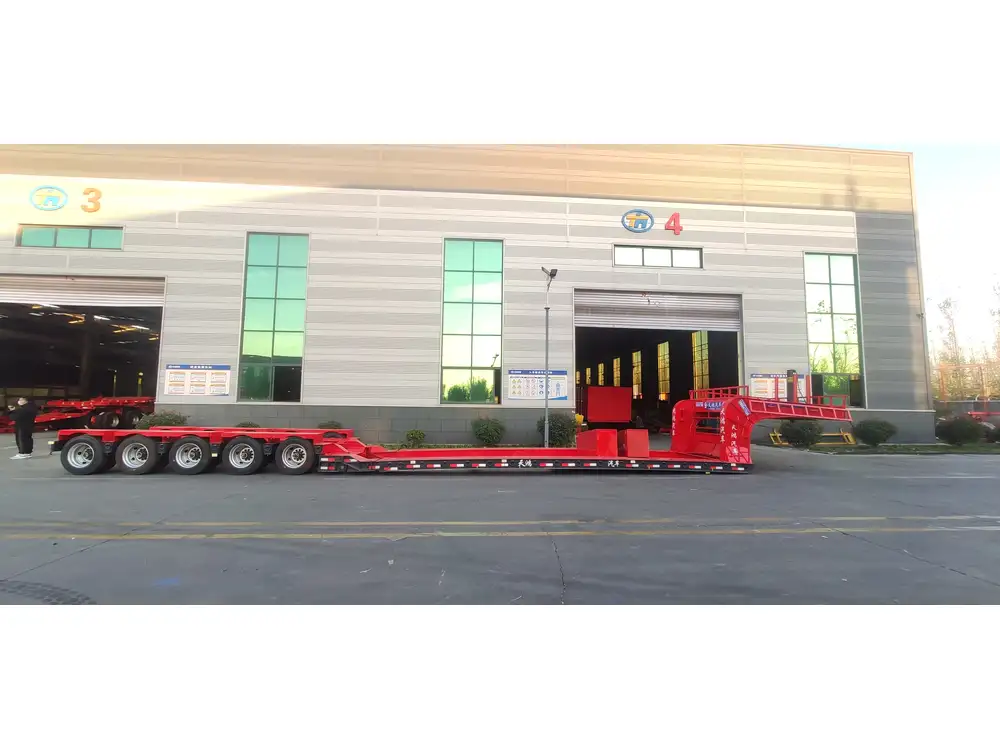
Frequently Asked Questions
1. What types of loads are best suited for lowboy trailers?
Lowboy trailers are ideal for transporting exceptionally heavy and oversized equipment, such as construction machinery, agricultural implements, mining equipment, and wind turbine components. Their low deck height allows for the safe and efficient transport of tall loads without exceeding height restrictions.
2. How does the suspension system in a lowboy trailer enhance performance?
The advanced suspension systems in lowboy trailers distribute the load evenly across multiple axles, reducing stress on the trailer and improving stability. This ensures smoother transit, minimizes wear and tear, and enhances overall performance, especially when navigating uneven terrains or carrying heavy loads.
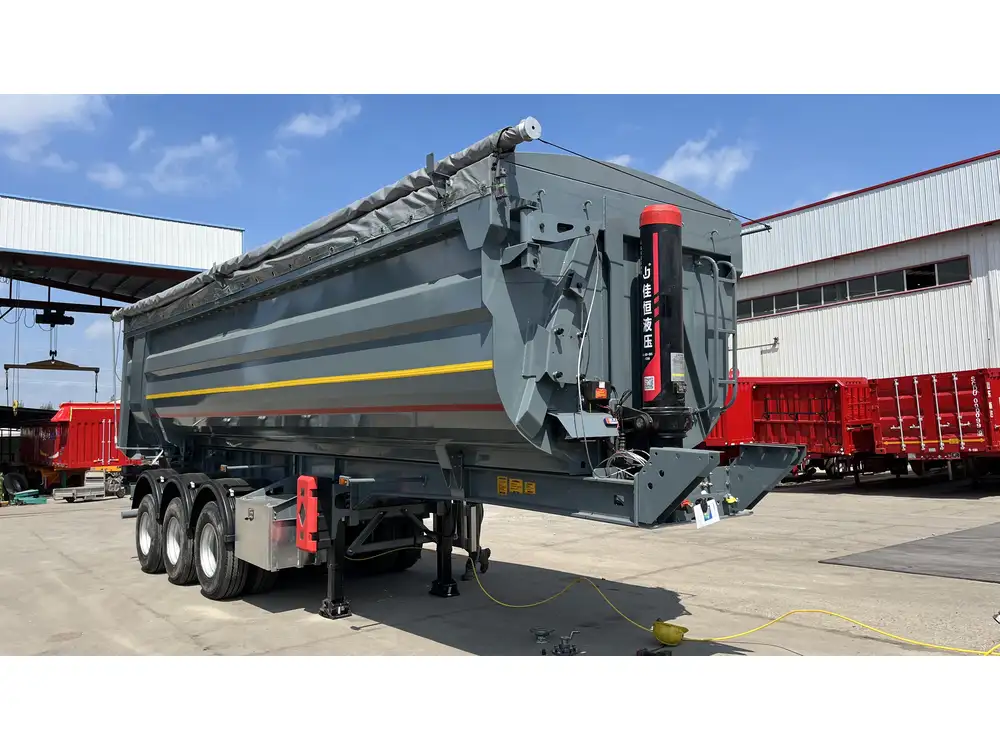
3. Can lowboy trailers be customized to specific needs?
Yes, lowboy trailers can be customized to meet specific transportation requirements. Customization options include varying deck lengths, axle configurations, suspension types, and additional features like adjustable decks or specialized tie-down points. At CarMax Vehicle, we work closely with clients to tailor trailers that perfectly align with their operational needs.
4. What maintenance practices are essential for lowboy trailers?
Essential maintenance practices include regular cleaning to prevent corrosion, routine inspections of structural components, lubrication of moving parts, brake system checks, tire maintenance, and ensuring all electrical systems are functioning properly. Adhering to a scheduled maintenance plan is crucial for maintaining the trailer’s longevity and performance.
5. How do lowboy trailers compare to flatbed trailers in terms of load stability?
Lowboy trailers generally offer better load stability compared to flatbed trailers due to their lower center of gravity. The reduced deck height minimizes the risk of load shifting and tipping, especially when transporting tall or unevenly distributed cargo. Additionally, the enhanced suspension systems in lowboys contribute to improved stability during transit.



